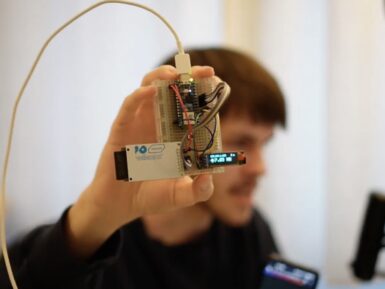
Overview
Grove Base Shield provides a simple way to connect with Arduino boards and help you get rid of breadboard and jumper wires. With the 16 on-board Grove Connectors, you can easily connect with over 300 Grove modules! The pinout of Base Shield V2 is compatible with the Arduino UNO, Arduino Leonardo and the Arduino Mega.
The Arduino Shield usually has the same pin position as the Arduino development board and can be stacked and plugged into the Arduino to implement specific functions.
Power Compatible:
Every Grove connector has four wires, one of which is the VCC. However, not every micro-controller main board needs a supply voltage of 5V, some boards only need 3.3V. That's why we add a power toggle switch to Base Shield V2 so that you can select the suitable voltage of the micro-controller main board you are using via this switch.
For example, if you are using Arduino UNO with Base Shield V2, please turn the switch to 5V position; while using Seeeduino Arch with Base Shield V2, please turn the switch to 3.3V.
Board Compatible:
The pinout of Base Shield V2 is the same as Arduino Uno R3, however Arduino Uno is not the only one that the Base Shield V2 is compatible with, here we listed the boards that we have confirmed that can be used with Base Shield V2:
- Arduino Uno
- Seeeduino V4.2
- Arduino Mega / Seeeduino Mega
- Seeduino LoraWan
- Arduino Leonardo / Seeeduino Lite
- Arduino 101
- Arduino Due
- Intel Edison
- Linkit One
Conformities
Get Inspired

I have prepare home Automoation project using Arduino nano esp32

Home file servers can be very useful for people who work across multiple devices and want easy access to their documents. And there are a lot of DIY build guides out there. But most of them are full-fledged NAS (network-attached storage) devices and they tend to rely on single-board computers. Those take a long time to boot and consume quite a lot of power. This lightweight file server by Zombieschannel is different, because it runs entirely on an Arduino. An ESP32 is a microcontroller with built-in connectivity (Wi-Fi and Bluetooth). Like all MCUs, it can “boot” and start running its firmware almost instantly. And while it runs, it will consume much less power than a conventional PC or a single-board computer. Zombieschannel’s project proves that the Arduino Nano ESP32 is suitable for a file server — if your expectations are modest. The hardware for this project consists of a Nano ESP32, an SD card reader module, and a small monochrome OLED screen. The SD card provides file storage and the OLED shows status information. Most of the work went into writing the firmware, which Zombieschannel did with assistance from ChatGPT. That has the Arduino hosting a basic web interface that local users can access to upload or download files. Zombieschannel also created a command line interface that provides more comprehensive access via a serial connection. This does have limitations and the transfer speeds are quite slow by modern standards. But the file server seems useful for small files, like text documents. Zombieschannel plans to design an enclosure for the device and it should tuck unobtrusively into a corner, where it can run without drawing much power.







